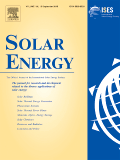Containment materials for liquid tin at 1350 °C as a heat transfer fluid for high temperature concentrated solar power


Abstract

One pathway for reducing the cost of concentrated solar power (CSP) is to increase the system efficiency by operating a heat engine with a higher hot side (inlet) temperature. If a turbine is used, then a system utilizing a combined cycle could potentially reach upwards of ∼60% efficiency, provided that the turbine could be operated with an inlet temperature >1300 °C. Such high temperatures place severe limits on heat transfer fluids; that is, such fluids would need to remain chemically stable, and be compatible with containment materials, at such extreme temperatures. One potential class of such fluids are liquid metals, such as molten tin. While possessing low melting and high boiling points (232 °C and 2600 °C, respectively) for a high operational range, molten tin also tends to be highly corrosive towards common structural metal alloys used as components for the containment and controlled flow of liquids (i.e., for pipes, tanks, valves, pumps, etc.). Thus, it would be useful to identify materials that are compatible with molten tin at ≥1300 °C. The purpose of this paper is to evaluate three candidate high-temperature materials, possessing a range of thermal conductivities, for the containment of molten tin: graphite (C), silicon carbide (SiC), and mullite (Al6Si2O13). The corrosion and penetration of these materials by molten Sn or doped Sn liquids at 1350 °C for 100 h were evaluated via local electron microscopic analyses and global weight change measurements. Under appropriate conditions, all three of these materials exhibited minimal to no reaction with tin-based liquids at 1350 °C and were not penetrated by these liquids at this temperature. This work indicates that graphite, silicon carbide, and/or mullite can serve as effective containment materials for the use of tin-based liquids as heat transfer fluids operating at 1350 °C in CSP plants.
